5 Days 4 Nights Chogoria Route down Sirimon Back from Nairobi
The Chogoria Route approaches Mount Kenya on the Eastern side via Chogoria town. It is much quieter on this side compared to the busy western slopes. The route is longer and more gradual which is perfect for acclimatization over a great 5-day trek. The scenery is stunning and has a fantastic charm as it brings a feeling of solitude and peace into a magnificent mountain hike. This route brings to life some of the most beautiful and scenic sites on the mountain. The trek passes two of the most iconic lakes on Mount Kenya, Lake Ellis and Lake Michaelson. Lake Michaelson is considered to be one of the most stunning locations on this great mountain. Set at the head of the Gorges Valley surrounded by 200m rock walls on each side that make up the Temple.
The Lakes are regularly stocked with Rainbow trout, providing a unique opportunity for the avid fly fisherman or woman. This is also just an amazing place to camp and relax after a long day trekking.
The Chogoria route is also your best chance to see wildlife and bird life whilst on Mount Kenya, some at higher altitudes than expected. If you are lucky you may even get a chance to see some wildlife on this trek.
All in all, the route is best done following this 7-day itinerary, with campsites set up by our team of trained local porters and guides. The team accompany you throughout your expedition.
Distance to the summit: 36 km
Altitude at the start: 2360m, 7,750ft
Altitude at the summit (Point Lenana): 4985m, 16,355ft
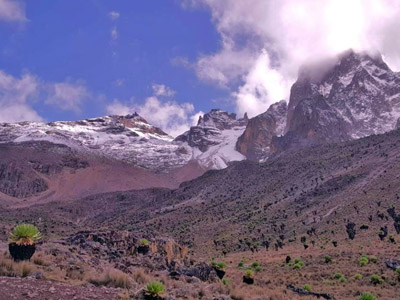
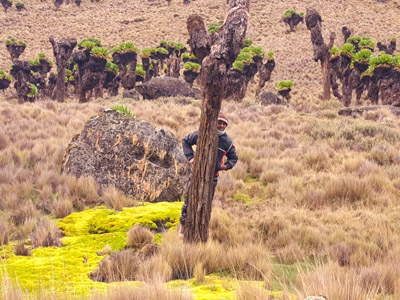
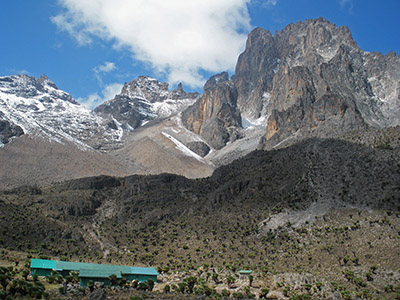
TRIP ITINERARY
01
Nairobi to Chogoria Camp (3,000m)
Trekking time: 4 hours.
After an early breakfast, you will meet our team in Nanyuki and be driven to the start of the route. The first day’s walk takes you up through the forest for about four hours to a clearing where you camp in a pocket of forest above the Kenya Wildlife Service entrance at Chogoria Bandas. If it is a clear afternoon you can generally get a good sense of the landscape from this point; where the Afro-alpine forest ends and the moorland begins. The afternoon is a good opportunity to walk around the area and acclimatize.
02
Chogoria Camp (3,000m) to Lake Ellis (3,460m)
Hiking time: 3 hours
Distance: About 12 km
Habitat: Montane forest
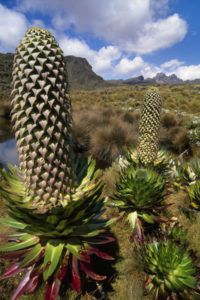
The walk starts with spectacular views of the rolling hills ahead and perhaps even a glimpse of the snow-capped peaks of Batian (5,199m) and Nelion (5,188m) high above.
This is a relatively short hike and you will arrive in camp a little earlier than the previous day, which gives you a great chance to sit back and relax after lunch and simply enjoy the views around Lake Ellis. We go by the general rule of thumb to “climb high and sleep low” to allow for better acclimatization. An evening walk up to nearby Mugi Hill can be a wonderful way to end the day and will hopefully make your ascent a lot easier as well. You can even try your hand at a spot of fly-fishing in the Lake.
03
Lake Ellis (3460m) to Lake Michaelson (4100m)
Hiking time: 5 hours
Distance: About 15 km
Habitat: Moorland
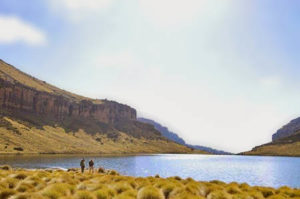
This day is a beautiful walk which takes you up along the ridge overlooking the Gorges valley and later on in the day Lake Michelson comes into view. We will break for lunch overlooking the Lake with a spectacular view, and then continue on a gentle traverse and descend to Lake Michaelson camp site. You can rest in the afternoon or go for a wander around the Lake.
04
Lake Michaelson (4,100m) to Austrian Hut (4,670m)
Hiking time: 4 hours
Distance: About 15 km
Habitat: Alpine desert
You will depart at around 9:00 am for a beautiful day’s walk around the peaks. There are many little tarns that you will encounter on your traverse. You will arrive at the Austrian Hut where you will have lunch. In the afternoon you can wander around along the edge of the Lewis Glacier and investigate the ice caves being formed as the glacier melts.
05
Austrian Hut (4,670m) to Point Lenana (4,985 M) to Old Moses
Hiking time: 8-10 hours
Distance: 6 km ascent – 21 km descent
Habitat: Stone scree and ice-capped summit
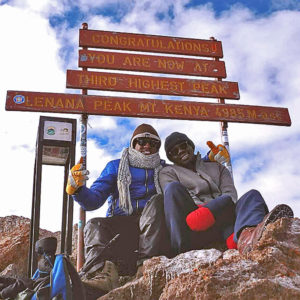
An early departure at 5:30 am for a sunrise summit is the best way to experience this climb and enjoy the expansive views of the mountainside, valleys and country beyond – even the summit of Kilimanjaro – whilst sipping a nice warm drink.
The descent takes you down the southern side along the Sirimon route where you will have brunch in the Mackinder Valley. Then it’s a final walk down to Old Moses for pick-up. You will be back in Nairobi between 5 and 6 o’clock.
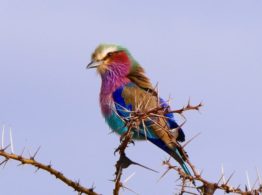
- Fitness enables fun
- Hydrate excessively
- Polé-polé (ask if you don’t know!)
- Stop & Listen
TIPS & TRICKS
After leading many successful trips into the mountains there are several “trekking-hacks” we like to tell our clients to help them better enjoy their time in the mountains.
- Ski sticks are useful when ascending the scree to the summit.
- Ski sticks also help protect your knees when traveling downhill!
- Filling your bottle at night with hot water creates a comforting heating pad to slip in your bag or beneath your pillow
- Powdered drink mix / sports mix helps with maintaining hydration (Tang, Gatorade, Lemonade)
- Find a pace to your hiking that you could keep at all day.
- Remember to pack some of your favorite snacks for a break on the trail.
More Information
Accommodations:
Accommodations on the route is in roomy two person tents or in huts. The choice of lodging is part your preference and part availability.
The tents are usually erected for you when you arrive, although if you want a particular position it’s worth taking charge. In the mornings it helps everyone to get away early if you lend a hand with taking the tents down.
Huts on the other hand can be warmer however you there may be other trekking parties besides yours inside the shelter.
Acclimatization:
Acclimatization is extremely important, both to let you enjoy your ascent but more importantly to avoid any serious complications. The route is planned to optimize the height gain, but you may still get a headache or feel nauseous. There are two important preventative measures: to drink copiously, even when it is really difficult, and to walk very slowly, avoiding as much as possible increased heart and breathing rates.
A drug is available, Diamox, from your doctor which is well proven to help with acclimatization. This is taken as tablets for a few days before and then during your ascent. It is safe and has no serious side effects.
It is important to remember that one possible effect of altitude is light-headedness and odd behavior, which can lead to foolish decisions. The danger here is someone who is not well insisting on continuing. Watch each other closely.
Water & Washing:
Water is available at several points and should be purified before drinking. All water in camp will be boiled and some provided for drinking the next day. A comforting tip is to fill your bottle in the evening with boiled water for the next day, and to use it as a hot water bottle overnight. Check with your guide where the water points are.
Washrooms are available at the huts but not the camps. Some camps have several and so it’s worth checking for the cleanest. If you are caught short during the walk, please find a spot as far as possible from the trail and any water. Bury your feces and paper. It is often easiest to move a large rock and use the indent as a hole. Mark your spot by balancing a couple of stones.
Trekking Fitness:
Most hiking is strenuous, but not technical climbing, and no mountain-climbing experience is necessary. But there’s no avoiding the steep ascents and high altitudes that make robust physical fitness (and a minimum age of 11 years) a prerequisite for any trip. You’ll want to consult your physician before undertaking this unforgettable adventure.
Mountain Cuisine:
The menus for all climbs are specially prepared to provide a balanced diet of fresh fruit, vegetables, plenty of protein and carbohydrates. We have tried to choose food items that are easiest to digest at high altitude.
Dinners are typically a main course with vegetable and salad. Chicken and fish are served at some of the days during the climb, with pastas and rice dishes being served in the middle of the climb while up high.
Lunches are often on the trail and usually consist of cold cuts and vegetables laid out on a table so you can make your own sandwich. Fresh hot vegetable soups are served at every meal, and packet soup is available on request between meals as is coffee and tea.
Breakfast is your choice: granola, toast, fruit, eggs, and sometimes pancakes or French toast.
Kitchen Safety:
Food and kitchen equipment will be carried by the porters and cooked by an experienced cook. It will be plentiful and wholesome but may be limited by the circumstances. Our cooks undergo extensive training and we have ongoing workshops to review menus. The cooks are particularly vigilant in their hygiene practices as contracting stomach bugs is common for visitors to the developing world.
Your own supply of chocolate and high energy snacks is a recommended.
While hiking some people have a favorite food that they like; it is a good idea to bring this from home.









